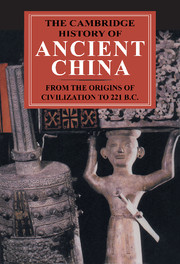Book contents
- Frontmatter
- Introduction
- 1 China on the Eve of the Historical Period
- 2 Language and Writing
- 3 Shang Archaeology
- 4 The Shang: China’s First Historical Dynasty
- 5 Western Zhou History
- 6 Western Zhou Archaeology
- 7 The Waning of the Bronze Age: Material Culture and Social Developments, 770–481 B.C.
- 8 The Spring and Autumn Period
- 9 Warring States Political History
- 10 The Art and Architecture of the Warring States Period
- 11 The Classical Philosophical Writings
- 12 Warring States Natural Philosophy and Occult Thought
- 13 The Northern Frontier in Pre–Imperial China
- 14 The Heritage Left to the Empires
- Bibliography
- Index
- Map 1 Topography of China
- Map 3.1 Archaeological sites of the Early Bronze Age
- Map 6.1 Archaeological sites of the Western Zhou period
- References
10 - The Art and Architecture of the Warring States Period
Published online by Cambridge University Press: 28 March 2008
- Frontmatter
- Introduction
- 1 China on the Eve of the Historical Period
- 2 Language and Writing
- 3 Shang Archaeology
- 4 The Shang: China’s First Historical Dynasty
- 5 Western Zhou History
- 6 Western Zhou Archaeology
- 7 The Waning of the Bronze Age: Material Culture and Social Developments, 770–481 B.C.
- 8 The Spring and Autumn Period
- 9 Warring States Political History
- 10 The Art and Architecture of the Warring States Period
- 11 The Classical Philosophical Writings
- 12 Warring States Natural Philosophy and Occult Thought
- 13 The Northern Frontier in Pre–Imperial China
- 14 The Heritage Left to the Empires
- Bibliography
- Index
- Map 1 Topography of China
- Map 3.1 Archaeological sites of the Early Bronze Age
- Map 6.1 Archaeological sites of the Western Zhou period
- References
Summary
The Warring States period was an era of magnificent artistic creation and renewal in Chinese history. By the end of the Spring and Autumn period, changes within traditional ritual art and architecture had reached a critical point. Many new artistic and architectural forms, styles, and genres appeared during the following centuries and redefined the whole visual vista. In architecture, the city was reshaped and its internal structure reconfigured. Tall platforms and terrace pavilions won great favor from political patrons, replacing the deep, enclosed compound of a traditional temple or palace to determine the center of a city or palace town. With their monumental appearance and dazzling ornamentation, these architectural forms supplied powerful visual symbols much needed by the new elite. In art also, the reaction against ritual bronzes – the dominant artistic genre during the Shang and Western Zhou – continued. Although vessels and other equipment made for ceremonial usage never disappeared, the ritual occasions that they served had gone through fundamental transformations, becoming increasingly mundane. The commemorative inscription declined further. Ornate interlacing patterns or depictions of human events transformed a bronze vessel into a carrier of geometric decoration or pictorial representation. Monochrome vessels had gone out of fashion; lacquers and inlaid objects, both reflecting a fascination with fluent imagery and coloristic effects, enjoyed great popularity. Beautifully decorated mirrors, belt hooks, and other types of personal belongings became major showpieces. Lamps, screens, tables, and other objects of daily use were created as serious works of art; combining expensive materials, exquisite work manship, and exotic images, these objects best documented the desire for material possession and the taste for extravagance.
- Type
- Chapter
- Information
- The Cambridge History of Ancient ChinaFrom the Origins of Civilization to 221 BC, pp. 651 - 744Publisher: Cambridge University PressPrint publication year: 1999
References
- 4
- Cited by

